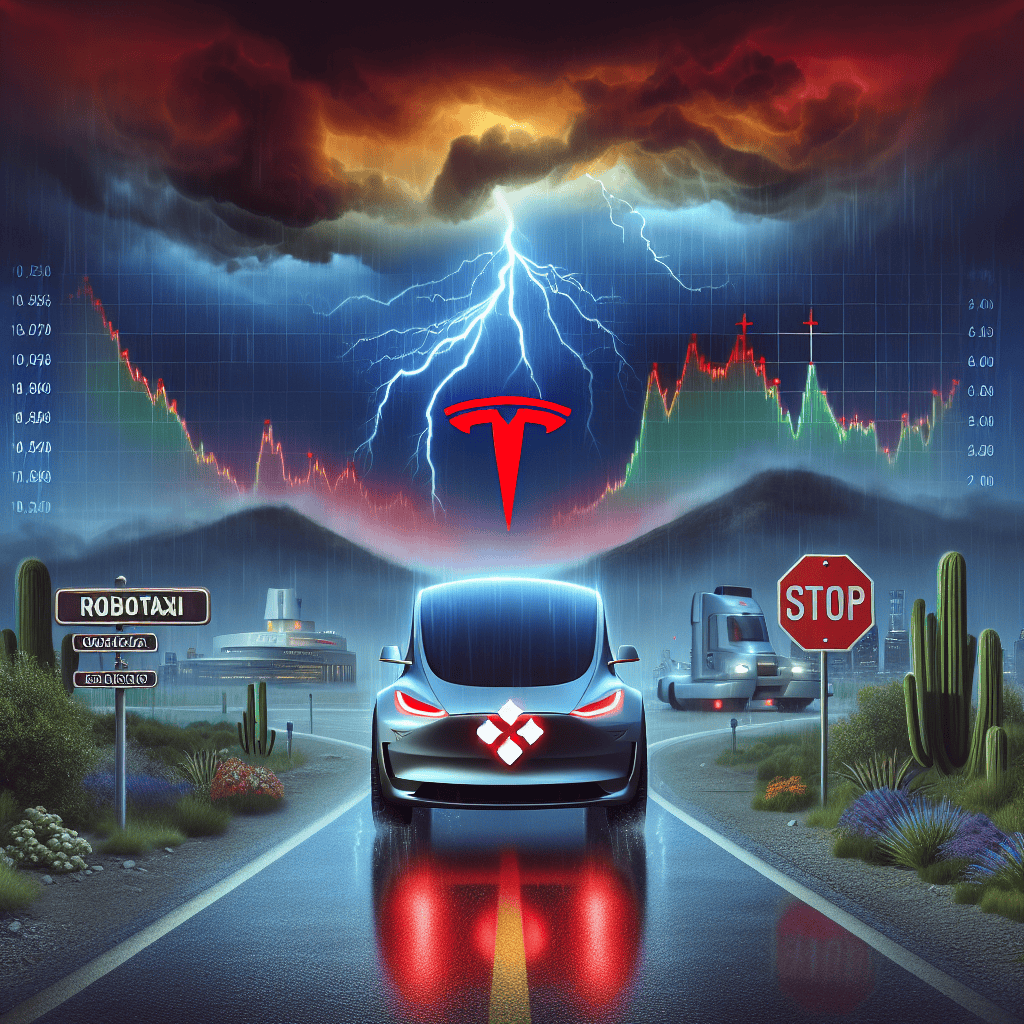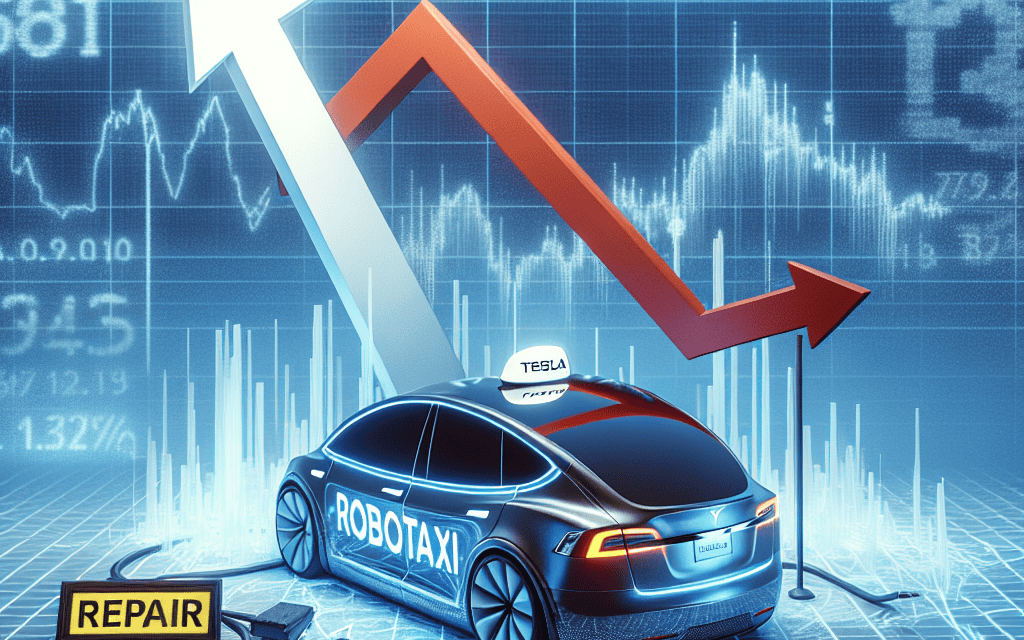“Tesla’s Road to Autonomy Hits a Speed Bump: Stock Faces Uncertainty After Robotaxi Setback”
Introduction
Tesla’s stock is facing a period of uncertainty following a significant setback in its ambitious robotaxi project. The electric vehicle giant, known for its innovative approach and disruptive technologies, has encountered challenges that have raised concerns among investors and market analysts. The robotaxi initiative, which was expected to revolutionize urban transportation and significantly boost Tesla’s revenue streams, has hit unforeseen obstacles, leading to delays and increased scrutiny. This development has prompted a reevaluation of Tesla’s growth prospects and has introduced volatility into its stock performance, as stakeholders assess the potential impact on the company’s long-term strategic goals.
Impact Of Robotaxi Setback On Tesla’s Stock Performance
Tesla’s stock has long been a focal point for investors, often characterized by its volatility and the ambitious vision of its CEO, Elon Musk. Recently, however, the company’s stock has faced uncertainty following a significant setback in its robotaxi initiative. This development has raised questions about Tesla’s future growth prospects and its ability to maintain its competitive edge in the rapidly evolving automotive industry. The robotaxi project, which aims to revolutionize urban transportation by deploying a fleet of autonomous vehicles, has been a cornerstone of Tesla’s long-term strategy. It promised not only to transform the way people commute but also to generate substantial revenue streams for the company. However, delays in regulatory approvals and technological challenges have hindered progress, casting doubt on the timeline for its implementation. Consequently, this has led to a ripple effect on Tesla’s stock performance.
Investors, who had been banking on the success of the robotaxi initiative, are now reassessing their positions. The uncertainty surrounding the project has introduced a level of risk that was previously underestimated. As a result, some investors have opted to divest, leading to fluctuations in Tesla’s stock price. This reaction underscores the market’s sensitivity to Tesla’s innovation-driven narrative and highlights the importance of meeting technological milestones. Moreover, the setback has intensified scrutiny from analysts and competitors alike. Analysts are now revisiting their projections for Tesla’s future earnings, factoring in the potential delays in the robotaxi rollout. This recalibration of expectations has contributed to a more cautious outlook on Tesla’s stock, as the market grapples with the implications of the setback.
In addition to investor sentiment, the robotaxi delay has also impacted Tesla’s competitive positioning. The autonomous vehicle space is becoming increasingly crowded, with traditional automakers and tech companies vying for a share of the market. Companies such as Waymo and Cruise have made significant strides in their autonomous vehicle programs, and any delay on Tesla’s part could potentially erode its first-mover advantage. This competitive pressure adds another layer of complexity to Tesla’s stock performance, as investors weigh the company’s ability to maintain its leadership in innovation. Furthermore, the robotaxi setback has broader implications for Tesla’s brand perception. The company has built its reputation on pushing the boundaries of technology and delivering groundbreaking products. Any perceived failure to deliver on its promises could affect consumer confidence and, by extension, sales of its existing vehicle lineup. This potential impact on revenue streams is another factor that investors are likely considering as they evaluate Tesla’s stock.
Despite these challenges, it is important to note that Tesla remains a formidable player in the automotive industry. The company has a track record of overcoming obstacles and achieving remarkable feats, which continues to inspire confidence among its loyal investor base. Additionally, Tesla’s diverse portfolio, which includes energy solutions and battery technology, provides a buffer against setbacks in any single initiative. In conclusion, while the robotaxi setback has undoubtedly introduced uncertainty into Tesla’s stock performance, it is not an insurmountable challenge. The company’s ability to navigate this setback will depend on its capacity to address regulatory and technological hurdles, as well as its agility in adapting to a competitive landscape. As investors and analysts continue to monitor developments, Tesla’s response to this setback will be crucial in shaping its future trajectory and stock performance.
Investor Reactions To Tesla’s Robotaxi Challenges
Tesla’s stock has long been a focal point for investors, driven by the company’s innovative approach to electric vehicles and its ambitious vision for the future of transportation. However, recent developments have cast a shadow over its stock performance, particularly following setbacks in its highly anticipated robotaxi project. This has led to a wave of reactions from investors, who are now grappling with the implications of these challenges on Tesla’s long-term growth prospects.
The robotaxi initiative, which aims to revolutionize urban mobility by deploying a fleet of autonomous vehicles, has been a cornerstone of Tesla’s strategy to dominate the transportation sector. The promise of a fully autonomous ride-hailing service has captivated investors, who see it as a potential game-changer that could significantly boost Tesla’s revenue streams. However, the project has encountered several hurdles, including regulatory challenges, technological obstacles, and competitive pressures, all of which have contributed to a growing sense of uncertainty.
In light of these setbacks, investor sentiment has become increasingly cautious. Many are now questioning the feasibility of Tesla’s ambitious timelines and the company’s ability to overcome the myriad challenges it faces. This skepticism is reflected in the stock’s recent volatility, as market participants reassess their expectations for the company’s future performance. The delay in the robotaxi rollout has also prompted some investors to reevaluate Tesla’s valuation, which has been buoyed by high expectations for its autonomous vehicle capabilities.
Moreover, the competitive landscape for autonomous vehicles is intensifying, with several major players making significant strides in the development of their own self-driving technologies. Companies such as Waymo, Cruise, and others are advancing rapidly, posing a formidable challenge to Tesla’s aspirations in the robotaxi market. This heightened competition has further fueled investor concerns, as it raises questions about Tesla’s ability to maintain its leadership position in the face of such formidable rivals.
Despite these challenges, it is important to note that Tesla remains a dominant force in the electric vehicle market, with a strong brand and a loyal customer base. The company’s continued innovation in battery technology and its expanding global footprint provide a solid foundation for future growth. However, the robotaxi setback underscores the complexities and uncertainties inherent in the pursuit of autonomous driving technology, which remains a nascent and rapidly evolving field.
In response to these developments, some investors are adopting a more cautious approach, opting to diversify their portfolios to mitigate potential risks associated with Tesla’s stock. Others, however, remain optimistic about the company’s long-term prospects, viewing the current challenges as temporary hurdles that Tesla will eventually overcome. This divergence in investor sentiment highlights the broader debate about the future of autonomous vehicles and the role Tesla will play in shaping that future.
In conclusion, Tesla’s robotaxi challenges have introduced a new layer of uncertainty for investors, prompting a reevaluation of the company’s growth trajectory and competitive positioning. While the setbacks have undoubtedly impacted investor confidence, they also serve as a reminder of the complexities involved in pioneering new technologies. As Tesla navigates these challenges, the company’s ability to adapt and innovate will be crucial in determining its future success and, by extension, the performance of its stock.
Future Prospects For Tesla’s Autonomous Vehicle Program
Tesla’s ambitious vision for a fully autonomous vehicle network has long been a cornerstone of its future growth strategy. However, recent setbacks in the development of its robotaxi program have cast a shadow over the company’s stock performance, raising questions about the future prospects of Tesla’s autonomous vehicle program. As investors and industry analysts scrutinize the implications of these delays, it is essential to explore the factors contributing to the current uncertainty and consider the potential paths forward for Tesla.
To begin with, Tesla’s robotaxi initiative was initially heralded as a revolutionary step in the automotive industry, promising to transform the way people perceive and utilize transportation. The concept of a fleet of self-driving Teslas operating as a ride-hailing service was expected to generate substantial revenue streams, thereby justifying the company’s high valuation. However, the technological and regulatory challenges associated with achieving full autonomy have proven to be more formidable than anticipated. Despite significant advancements in Tesla’s Autopilot and Full Self-Driving (FSD) systems, the company has yet to deliver a vehicle capable of operating without human intervention in all conditions.
Moreover, the regulatory landscape for autonomous vehicles remains complex and fragmented, with different regions imposing varying standards and requirements. This inconsistency poses a significant hurdle for Tesla, as it must navigate a patchwork of regulations to deploy its robotaxi service on a global scale. The lack of a unified regulatory framework not only delays the rollout of autonomous vehicles but also increases the cost and complexity of compliance, further complicating Tesla’s efforts to bring its vision to fruition.
In addition to these challenges, Tesla faces mounting competition from both established automakers and tech companies that are investing heavily in autonomous vehicle technology. Companies such as Waymo, Cruise, and Argo AI have made significant strides in developing self-driving systems, often with the backing of substantial financial resources and strategic partnerships. This competitive pressure underscores the urgency for Tesla to overcome its current setbacks and demonstrate tangible progress in its autonomous vehicle program.
Despite these obstacles, it is important to recognize that Tesla possesses several key advantages that could bolster its prospects in the autonomous vehicle space. The company’s extensive data collection capabilities, derived from its large fleet of vehicles equipped with Autopilot, provide a valuable resource for refining and improving its self-driving algorithms. Furthermore, Tesla’s vertically integrated approach, encompassing hardware, software, and manufacturing, allows for greater control and flexibility in the development process.
Looking ahead, Tesla’s ability to navigate the challenges facing its robotaxi program will be crucial in determining the future trajectory of its stock. While the current uncertainty may weigh on investor sentiment in the short term, successful resolution of these issues could unlock significant value and reaffirm Tesla’s position as a leader in the autonomous vehicle industry. In the meantime, stakeholders will be closely monitoring Tesla’s progress, seeking signs of advancement in both technology and regulatory compliance.
In conclusion, while Tesla’s robotaxi setback has introduced a degree of uncertainty regarding the company’s autonomous vehicle program, it is essential to consider the broader context and potential for future growth. By leveraging its unique strengths and addressing the challenges at hand, Tesla has the opportunity to redefine the landscape of transportation and solidify its role as a pioneer in the field of autonomous driving.
Analyzing Tesla’s Stock Volatility Amidst Robotaxi Delays

Tesla’s stock has long been a focal point for investors, characterized by its volatility and the company’s ambitious vision for the future. Recently, this volatility has been exacerbated by setbacks in Tesla’s highly anticipated robotaxi project. The delay in the rollout of autonomous vehicles has raised questions about the company’s ability to deliver on its promises, thereby impacting investor confidence and contributing to fluctuations in its stock price. Understanding the implications of these delays requires a closer examination of both the technological challenges and the broader market dynamics at play.
To begin with, Tesla’s robotaxi initiative is a critical component of its long-term strategy, aimed at revolutionizing urban transportation and creating a new revenue stream. The concept of a fleet of self-driving taxis has captured the imagination of both the public and investors, promising a future where transportation is more efficient, cost-effective, and environmentally friendly. However, the path to achieving full autonomy is fraught with technical hurdles. Despite significant advancements in artificial intelligence and machine learning, developing a vehicle that can safely navigate complex urban environments without human intervention remains a formidable challenge. These technological obstacles have contributed to the delays, as Tesla works to ensure that its autonomous systems meet stringent safety and regulatory standards.
Moreover, the regulatory landscape for autonomous vehicles is still evolving, adding another layer of complexity to Tesla’s robotaxi ambitions. Governments around the world are grappling with how to regulate self-driving cars, balancing innovation with public safety. This regulatory uncertainty can lead to delays in the deployment of autonomous vehicles, as companies like Tesla must navigate a patchwork of rules and requirements. Consequently, these regulatory challenges have a direct impact on Tesla’s timeline for launching its robotaxi service, further influencing investor sentiment.
In addition to these challenges, Tesla faces increasing competition in the autonomous vehicle space. Established automakers and tech companies are investing heavily in self-driving technology, each vying for a share of the burgeoning market. This competitive pressure can affect Tesla’s market position and, by extension, its stock performance. Investors are keenly aware of the competitive landscape and may adjust their expectations based on how Tesla’s progress compares to that of its rivals.
Despite these setbacks, it is important to recognize that Tesla has a history of overcoming obstacles and achieving remarkable feats. The company has consistently pushed the boundaries of what is possible in the automotive industry, from pioneering electric vehicles to developing cutting-edge battery technology. This track record of innovation provides a degree of reassurance to investors, even amidst current uncertainties. Furthermore, Tesla’s strong brand and loyal customer base continue to be valuable assets, helping to sustain interest in the company’s long-term vision.
In conclusion, while the delays in Tesla’s robotaxi project have introduced a degree of uncertainty into its stock performance, they also highlight the complex interplay of technological, regulatory, and competitive factors that the company must navigate. As Tesla continues to address these challenges, its ability to adapt and innovate will be crucial in determining its future trajectory. Investors will be closely monitoring the company’s progress, weighing the potential risks and rewards associated with its ambitious plans. Ultimately, Tesla’s stock volatility serves as a reminder of the inherent uncertainties in pioneering new technologies and the importance of maintaining a balanced perspective when evaluating the company’s prospects.
Strategic Adjustments Tesla Might Consider Post-Setback
Tesla’s recent setback in its ambitious robotaxi project has sent ripples through the financial markets, leading to a period of uncertainty for its stock. This development has prompted analysts and investors alike to speculate on the strategic adjustments the company might consider to navigate this challenging phase. As Tesla grapples with the implications of this delay, it is crucial to explore potential strategies that could help the company maintain its competitive edge and reassure stakeholders.
To begin with, Tesla might consider diversifying its product portfolio to mitigate the impact of the robotaxi setback. While the company has already established itself as a leader in electric vehicles, expanding into other areas of sustainable technology could provide new revenue streams. For instance, Tesla could intensify its focus on energy storage solutions, such as its Powerwall and Powerpack products, which have shown promise in both residential and commercial markets. By capitalizing on the growing demand for renewable energy solutions, Tesla could offset some of the financial uncertainties stemming from the robotaxi delay.
In addition to diversification, Tesla could also enhance its research and development efforts to accelerate the progress of its autonomous driving technology. By investing in cutting-edge research and forming strategic partnerships with technology firms, Tesla could address the technical challenges that have hindered the robotaxi project. Collaborations with companies specializing in artificial intelligence and machine learning could provide Tesla with the expertise needed to refine its autonomous systems. This approach would not only expedite the development process but also demonstrate Tesla’s commitment to innovation, potentially restoring investor confidence.
Moreover, Tesla might benefit from revisiting its global expansion strategy. While the company has made significant strides in establishing a presence in key international markets, there remains untapped potential in emerging economies. By tailoring its products to meet the specific needs and preferences of these markets, Tesla could capture a larger share of the global electric vehicle market. This expansion could be supported by localized production facilities, which would reduce costs and improve supply chain efficiency. Such strategic moves could help Tesla maintain its growth trajectory despite the robotaxi setback.
Furthermore, Tesla could explore opportunities to strengthen its brand image and customer loyalty. In times of uncertainty, maintaining a strong connection with consumers is paramount. Tesla could achieve this by enhancing its customer service offerings and engaging with its community through innovative marketing campaigns. By emphasizing its commitment to sustainability and cutting-edge technology, Tesla can reinforce its brand identity and foster a sense of trust and loyalty among its customer base.
Finally, Tesla might consider financial strategies to stabilize its stock performance. This could involve stock buybacks or issuing dividends to reassure investors of the company’s financial health. Additionally, transparent communication regarding the progress of the robotaxi project and other initiatives could alleviate investor concerns and reduce market volatility.
In conclusion, while the robotaxi setback presents a significant challenge for Tesla, it also offers an opportunity for strategic realignment. By diversifying its product offerings, enhancing research and development, expanding globally, strengthening its brand, and implementing financial strategies, Tesla can navigate this period of uncertainty and emerge stronger. As the company adapts to these challenges, it will be crucial for Tesla to maintain its focus on innovation and sustainability, ensuring its continued leadership in the rapidly evolving automotive industry.
Comparing Tesla’s Autonomous Vehicle Efforts With Competitors
Tesla’s ambitious vision for a future dominated by autonomous vehicles has long been a cornerstone of its strategy, with the promise of a fully operational robotaxi fleet capturing the imagination of investors and consumers alike. However, recent setbacks in the development and deployment of these autonomous vehicles have cast a shadow over Tesla’s stock, prompting a closer examination of how the company measures up against its competitors in the autonomous vehicle space. As the race to achieve full autonomy intensifies, understanding the comparative landscape becomes crucial for stakeholders.
To begin with, Tesla’s approach to autonomous driving is distinct in its reliance on a vision-based system, utilizing cameras and neural networks to interpret and navigate the driving environment. This strategy contrasts with many of its competitors, such as Waymo and Cruise, which employ a combination of sensors, including LiDAR, radar, and cameras, to achieve a more comprehensive understanding of their surroundings. While Tesla argues that its camera-centric approach is more scalable and cost-effective, critics point out that the absence of LiDAR may limit the system’s ability to accurately perceive depth and detect obstacles in certain conditions.
Moreover, Tesla’s Full Self-Driving (FSD) software, which is currently in beta testing, has faced scrutiny over its performance and safety. Despite impressive demonstrations of its capabilities, the software has been criticized for inconsistencies and occasional failures in complex driving scenarios. In contrast, Waymo, a subsidiary of Alphabet Inc., has been operating fully autonomous vehicles without safety drivers in select areas, showcasing a level of maturity and reliability that Tesla has yet to achieve. Waymo’s extensive testing and cautious deployment strategy have earned it a reputation for safety and dependability, setting a high bar for Tesla and others in the industry.
Additionally, General Motors’ Cruise division has made significant strides in the autonomous vehicle sector, with its focus on urban environments and ride-hailing services. Cruise has been conducting driverless rides in San Francisco, demonstrating its commitment to real-world applications and consumer readiness. This progress highlights the competitive pressure Tesla faces as it seeks to transition from a predominantly electric vehicle manufacturer to a leader in autonomous technology.
Furthermore, the regulatory landscape presents another layer of complexity for Tesla and its competitors. Autonomous vehicle regulations vary significantly across regions, with some areas adopting more stringent safety standards and testing requirements. Tesla’s global ambitions necessitate navigating this intricate web of regulations, which can impact the pace of deployment and market penetration. In contrast, companies like Waymo and Cruise have concentrated their efforts in specific regions, allowing them to tailor their strategies to local regulatory environments and gain a foothold in key markets.
In light of these challenges, Tesla’s stock has experienced volatility, reflecting investor concerns about the company’s ability to deliver on its autonomous vehicle promises. While Tesla remains a formidable player in the electric vehicle market, its success in the autonomous domain is far from guaranteed. The setbacks in its robotaxi program underscore the complexities and uncertainties inherent in developing fully autonomous vehicles. As Tesla continues to refine its technology and address these challenges, its performance relative to competitors will be closely watched by investors and industry observers alike. Ultimately, the outcome of this race will have profound implications not only for Tesla’s stock but also for the future of transportation as a whole.
Long-Term Implications Of Robotaxi Setback On Tesla’s Market Position
Tesla’s ambitious vision of a fully autonomous robotaxi network has long been a cornerstone of its strategy to revolutionize the transportation industry. However, recent setbacks in the development and deployment of this technology have cast a shadow over the company’s stock, raising questions about its long-term market position. The implications of these challenges are multifaceted, affecting not only Tesla’s financial outlook but also its competitive standing in the rapidly evolving automotive sector.
To begin with, the delay in the robotaxi rollout has significant financial ramifications for Tesla. The company has invested heavily in the research and development of autonomous driving technology, with the expectation that a successful launch would open up new revenue streams and enhance profitability. The setback, therefore, not only postpones potential earnings but also increases the pressure on Tesla to justify its substantial R&D expenditures. Investors, who have been banking on the promise of high-margin robotaxi services, may grow increasingly impatient, potentially leading to volatility in Tesla’s stock price.
Moreover, the delay could impact Tesla’s brand perception. The company has built its reputation on innovation and the ability to deliver cutting-edge technology ahead of its competitors. A prolonged setback in the robotaxi initiative might lead to skepticism about Tesla’s technological capabilities and its ability to meet ambitious timelines. This could erode consumer confidence and give competitors an opportunity to catch up or even surpass Tesla in the race to develop autonomous vehicles. Companies like Waymo and Cruise, which have made significant strides in autonomous driving, could capitalize on Tesla’s delay to strengthen their market positions.
In addition to financial and reputational concerns, the robotaxi setback has broader implications for Tesla’s strategic direction. The company may need to reassess its priorities and allocate resources more efficiently to ensure continued growth and innovation. This could involve a shift in focus towards other areas of its business, such as energy solutions or the expansion of its electric vehicle lineup. By diversifying its offerings and reducing reliance on a single, yet-to-be-realized technology, Tesla can mitigate the risks associated with the robotaxi delay and maintain its competitive edge.
Furthermore, the setback underscores the inherent challenges of developing fully autonomous vehicles. Regulatory hurdles, technological complexities, and safety concerns all contribute to the difficulty of bringing robotaxis to market. Tesla’s experience serves as a reminder that the path to autonomy is fraught with obstacles, and success is not guaranteed. This realization may prompt a more cautious approach from both Tesla and its investors, with a greater emphasis on incremental progress and realistic timelines.
Despite these challenges, it is important to recognize that Tesla remains a formidable player in the automotive industry. The company’s strong brand, loyal customer base, and continued leadership in electric vehicle sales provide a solid foundation for future growth. While the robotaxi setback presents a significant hurdle, it is not insurmountable. By learning from this experience and adapting its strategy accordingly, Tesla can continue to innovate and maintain its position as a leader in the transition to sustainable transportation.
In conclusion, the long-term implications of the robotaxi setback on Tesla’s market position are complex and multifaceted. While the delay poses challenges in terms of financial performance, brand perception, and strategic direction, it also offers an opportunity for reflection and recalibration. By addressing these issues head-on and leveraging its existing strengths, Tesla can navigate this period of uncertainty and emerge stronger in the competitive landscape of the automotive industry.
Q&A
1. **What caused the uncertainty in Tesla’s stock?**
The uncertainty was caused by setbacks in Tesla’s robotaxi program.
2. **What is the robotaxi program?**
The robotaxi program is Tesla’s initiative to develop autonomous vehicles that can operate as self-driving taxis.
3. **How did the setback affect investor confidence?**
The setback led to decreased investor confidence due to concerns about Tesla’s ability to deliver on its autonomous driving promises.
4. **What are the potential financial implications for Tesla?**
The financial implications could include delayed revenue from the robotaxi service and increased costs related to further development and regulatory compliance.
5. **How has Tesla’s stock price reacted to the news?**
Tesla’s stock price experienced volatility and potential declines following the news of the setback.
6. **What are analysts saying about Tesla’s future prospects?**
Analysts have mixed opinions, with some expressing concern over the delays and others remaining optimistic about Tesla’s long-term potential in the autonomous vehicle market.
7. **What steps is Tesla taking to address the setback?**
Tesla is likely focusing on improving its autonomous driving technology and working with regulators to address any compliance issues.
Conclusion
Tesla’s stock faces uncertainty following a setback in its robotaxi initiative, which was anticipated to be a significant driver of future growth and revenue. The delay or challenges in deploying a fully autonomous ride-hailing service have raised concerns among investors about the company’s ability to maintain its competitive edge in the rapidly evolving autonomous vehicle market. This uncertainty may lead to increased volatility in Tesla’s stock price as investors reassess the company’s long-term growth prospects and its ability to deliver on ambitious technological promises. Additionally, the setback could impact Tesla’s strategic positioning against competitors who are also advancing in the autonomous vehicle space, potentially affecting market share and investor confidence.





